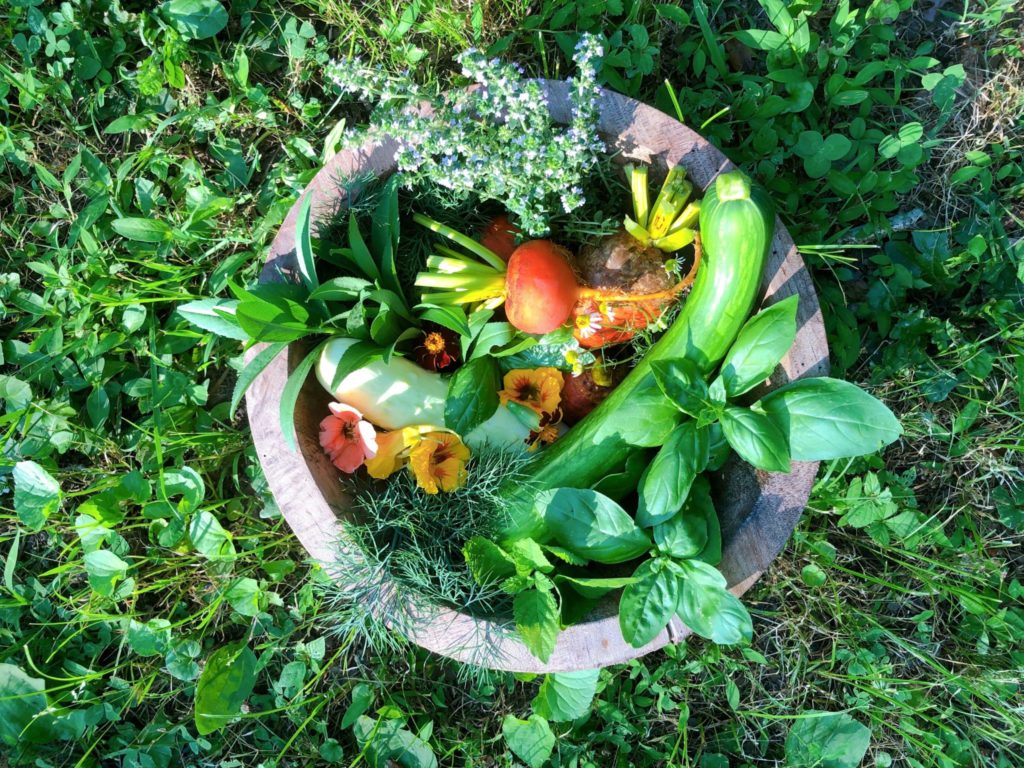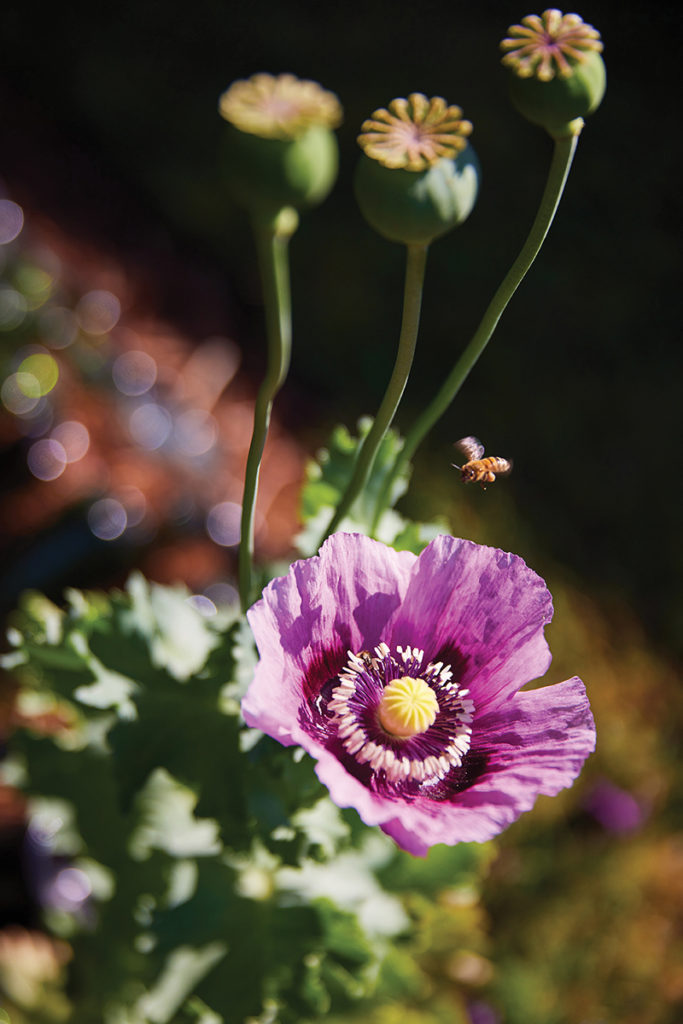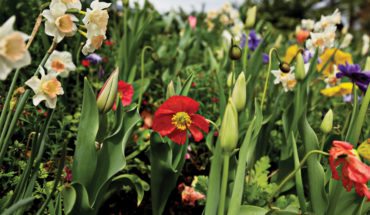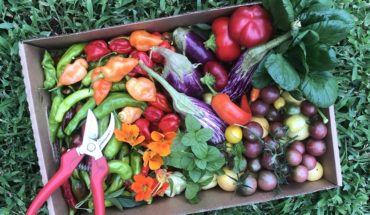Prepare your plants the summer heat by establishing a new watering schedule, pruning thoughtfully, and experimenting with edible flowers.
by Hannah Ross
As summer starts to seal itself over the South, spring dissipates like early morning dew in the sun. June offers a unique sensory moment as we savor the last tastes of crisp asparagus and sweet strawberries alongside the firsts of summer. In the garden, I treasure this moment, when tender herbs like dill and earthy roots such as Hakurei turnips mingle in my basket with early cucumbers and cherry tomatoes. With this spring-meets-summer abundance comes the necessity to multitask in the yard and garden— juggling planting, tending, pruning, harvesting and planning in an ongoing dance.
Gardening isn’t easy work — especially in summer — so make sure to celebrate the fruits of your labor by lighting up the grill and enjoying fresh salads, tender vegetables kissed by the flame, juicy berry pies, and your family’s seasonal favorites outside. If you didn’t get around to gardening this season, or don’t have the space to do so, don’t worry — we live in a region rich with beautiful food and talented farmers. Visit the farmer’s market in June to indulge in the transient moment when bountiful berries and stone fruits briefly overlap, blanketing the wooden benches like jewels alongside heaps of tomatoes, cucumbers and squashes. I hope the following eight tips will help you make the most of June’s joyful, transitional offerings — from the garden or market to your home sweet home.
Savor the Last of Spring
If you planted flowers, herbs or vegetables for spring, take time to savor their fleeting presence. Snip lingering spring blooms like peonies and foxgloves for enjoyment indoors. Use bud vases to display individual blooms, meditating on the particular beauty of each before it’s time to say, see you next year.
If you grew poppies this season, save the giant seed pods for fall planting: cut a handful of podded stems, cover the pods with a paper bag, wrap a rubber band around the bundle, and hang the pods upside down to dry (the bag catches the seeds which fall out as the pods dry). Store poppy seeds in a labeled container and refer back to my guidance for fall-planting of spring flowers come October.
Don’t be Bothered by the Bolt
As temperatures rise, many spring vegetables and herbs will bolt — sending sturdy stalks up towards the sun, forming flowers followed by seeds. At this point, leaf and root vegetables become unpalatable, so many gardeners quickly yank out bolting plants. However, there are several benefits to letting them linger.
First, pollinators flock to the flowers of bolting vegetables like arugula and radish, and attracting those pollinators can help increase pollination of your new summer plantings. Also, the flowers and seeds of many spring-grown veggies and herbs are edible, even as the leaves and roots grow bitter. Try harvesting your own cilantro seed (aka coriander) or fennel seed for use in your kitchen year-round — you won’t believe the vibrant flavor compared to store bought spices. Pick and enjoy flowers from arugula, radish and kale in salads and pestos, and begin to explore the playful magic of edible flowers in the kitchen.
Have Fun with Edible Flowers
Once you try harvesting and enjoying the flowers of bolting spring vegetables, you may wish to extend your edible flower harvest through the summer. The flower world is full of diverse and interesting flavors, textures and medicinal properties. Incorporating flowers into your culinary routine can bring an enlivening sense of creativity and fun. To pick edible flowers all summer, plant marigolds, calendula, borage, dahlias, hibiscus, chive, butterfly pea vine, rose and nasturtiums. If you have spring blooms lingering this month, enjoy tasting snapdragons, bachelor’s buttons, dianthus, pansies and violas. For larger blooms like snapdragons and giant marigolds, the flower heads can be picked apart for their individual petals.
Flower petals are so delicate that they generally should be enjoyed raw; they keep for at least a week refrigerated in a dry, sealed container.
In addition to their obvious usefulness for dessert decorating, edible flowers are endlessly adaptable. Try infusing jams, shrubs and syrups with rose or hibiscus flowers for a nuanced floral flavor that makes sweetness more interesting. Fill compound butters, dips or soft cheeses with confetti made by smaller petals like borage (which has a cucumber-like flavor) and calendula (which is mildly bitter). Enliven salads with color and flavor using chive blossoms and peppery nasturtiums. Jazz up cocktail flavor and presentation with mild-flavored blooms; try butterfly pea with lemon for a shock of color. Finally, level-up your plating skills when guests come for dinner by adorning dishes with petals or herb leaves that complement the colors and textures of your dishes.
Keep Planting for Summer
If you planted vegetables and annuals over the past two months, you’re doing great. Plant another round of favorite summer annuals in June to help prolong your harvest into fall. And if time got the best of you this spring, don’t worry — June is still a perfectly suitable month to plant most summer vegetables and flowers with plenty of time to enjoy them before autumn.
Now that day and nighttime temperatures are steadily warm, there’s no need to start seeds indoors. Instead, embrace quick-growing plants for direct-sowing (planting seeds straight into your garden soil), or buy healthy transplants from the local garden center.
Excellent plants to direct sow this month include: cucumbers, summer or winter squash, zucchini, beans, melon, sunflower, basil, nasturtium, zinnia, marigold, amaranth, gomphrena and celosia. Depending on the variety, you may be able to start peppers, tomatoes or eggplant directly from seed, but transplanting is recommended at this point.
While seed shopping, check the “days to maturity” on the seed packet, and count from the current date to the first frost (around mid-October). By June, anything that will take more than 120 days to mature is pushing close to the first frost date; purchase and transplant those longer-maturing plants, and focus on direct-sowing the quicker-maturing varieties for the rest of summer.
Train Vegetable Plants for Healthy Growth
If you have not yet set up trellises, cages, stakes or other supports for your tall, branching and vining summer vegetables, now is the time. With the steady warmth and rain we are experiencing, plant growth through June will no doubt come at a frenzied pace. Help your plants grow effectively by training them to grow up the supports you’ve provided.
Vining plants like cucumbers and pole beans may need help at first finding and latching onto your trellis; their tendrils will take it from there. Tall, branching plants like eggplant and peppers benefit from being loosely tied with twine to wooden stakes or bamboo poles; providing stakes early will help keep plants growing straight towards the sun, rather than falling over and growing at tricky-to-manage angles.
However you’ve decided to trellis your tomatoes, you can make the work of tending them infinitely easier by routinely pruning out tomato suckers. In the angle between the main stem and each lateral branch, tomatoes often sprout smaller, more tender shoots known as suckers. While it can seem ideal to let tomato plants grow wild with as many branches as possible, leaving all the suckers intact will lead to a sprawling mess of a plant that is difficult to manage. By pruning off the suckers, we can actually help tomato plants to focus their energy into flower and fruit production. In addition to pruning suckers, I like to snip off all foliage below the first set of flowers to encourage healthy airflow around the base of each tomato plant.
Pinch and Prune for Better Blooms
The biggest secret to abundant blooms and prolific, tender herb harvests is pinching. By using your fingers or sharp snips to remove the central growing tip of a young plant just above the second or third leaf node, you encourage a sturdy, branching growth habit that leads to exponentially more flower buds over the course of the season. For branchy herbaceous plants like zinnias, dahlias and basil, going unpinched leads to spindly, leggy growth and fewer flowering stems. Plants that don’t require pinching are those that either grow naturally low to the ground in a mounding habit (like thyme or nasturtium), or that produce one hefty flowering stem rather than a spray of branches (like cockscomb celosia or giant sunflowers).
Many flowering perennials benefit from pruning in spring by snipping spent flowering stems back to ground level. Similar to pinching, making this deep cut encourages lush new growth, which will grow happily in this warm, wet time of year. Some spring-flowering perennials may reward gardeners with a second flush of blooms if pruned in June. Avoid pruning summer-blooming perennials in June, as this may stunt flowering. If you’re unsure about what to prune and what not to prune (I get it, it’s nerve wracking), consult the helpful chart at the end of this article from Piedmont Master Gardeners. This resource is from the Piedmont of Virginia rather than North Carolina, but their recommendations still apply.
Another pruning task for June is cutting back the limp foliage of spring-flowering bulbs. If you have daffodils especially, you’ve likely noticed the leaves starting to brown and flop over. These are signs that the foliage has finished photosynthesizing for the season, and the bulbs have collected the energy they need for next year’s blooms. The tired foliage is ready to be cut back to ground level — a satisfying task that makes the garden look much more tidy.
Shop for Late Summer and Fall Bulbs
While it’s not our natural inclination in June to think about fall planting, this is an opportune time to get first dibs on popular varieties of fall-planted bulbs. From daffodils and tulips to garlic and shallots, placing an order in early summer means you’ll be set up for success in October and November when their planting is ideally done. Many seed companies offer fall flower bulbs and seed garlic, but Peaceful Valley Farm Supply, Johnny’s Selected Seeds, Van Engelen and Territorial Seed are excellent places to start your shopping. Just store bulbs in a cool, dark pantry or in the fridge until you’re ready to plant them.
Thinking in the nearer term, now is an excellent moment to expand or build your bearded iris collection from companies like Schreiner’s Irises (who ship from August to September), Terra Ceia Farms (who start shipping in October) and Old House Gardens (who ship in July). Irises bring an ethereal, impressionist glow to the spring garden and come in a stunning palette of watercolor shades. Not to mention, they’re easy.
Nourish Hungry Plants for Happy Growth
As summer’s heat sets in this month, make sure to establish a regular watering routine to carry your young plants through the season. Whether you have drip irrigation, self-watering pots or plan to water by hand, plants do best with a reliable schedule. It can be tempting to water a little bit every day; instead, water deeply a couple of times a week. Watering deeply and less frequently encourages plants to establish deep roots, searching for stores of water in the soil, instead of relying solely upon what’s on the surface. Plants that are only watered shallowly develop shallow root systems that are vulnerable to wilt during droughts or topple during storms.
The best way to prevent pests and disease in the garden is to practice preventive care, keeping plants consistently well-nourished throughout the growing season. Foliar feeding with an organic liquid fertilizer (such as Neptune’s Harvest seaweed and fish emulsion) once or twice a month is an excellent way to keep plants happy and healthy. That’s not to say we don’t all encounter pests in summer — it’s inevitable and not a failure on the part of the gardener — but starting with healthy plants is the best way to keep problems manageable in scale.
If you’re working with a small raised bed or container garden, mix the liquid fertilizer into your watering can and water as you normally would (the bottle will tell you how much fertilizer per gallon). For larger spaces, using a backpack sprayer helps make the task of foliar feeding more efficient. Establishing a routine of healthy habits before peak summer— including regular weeding, watering, pruning, and fertilizing— helps set the garden up for success.





